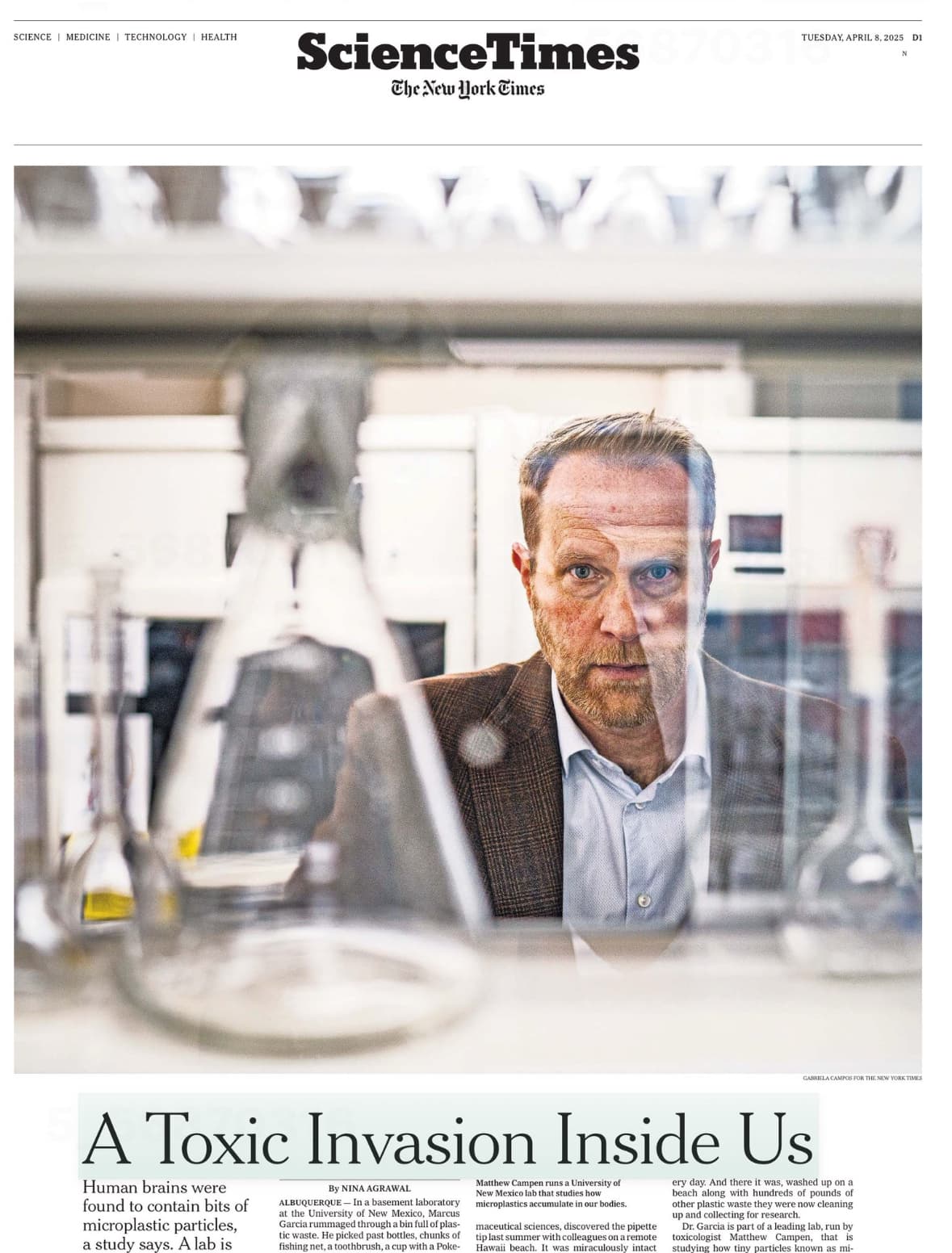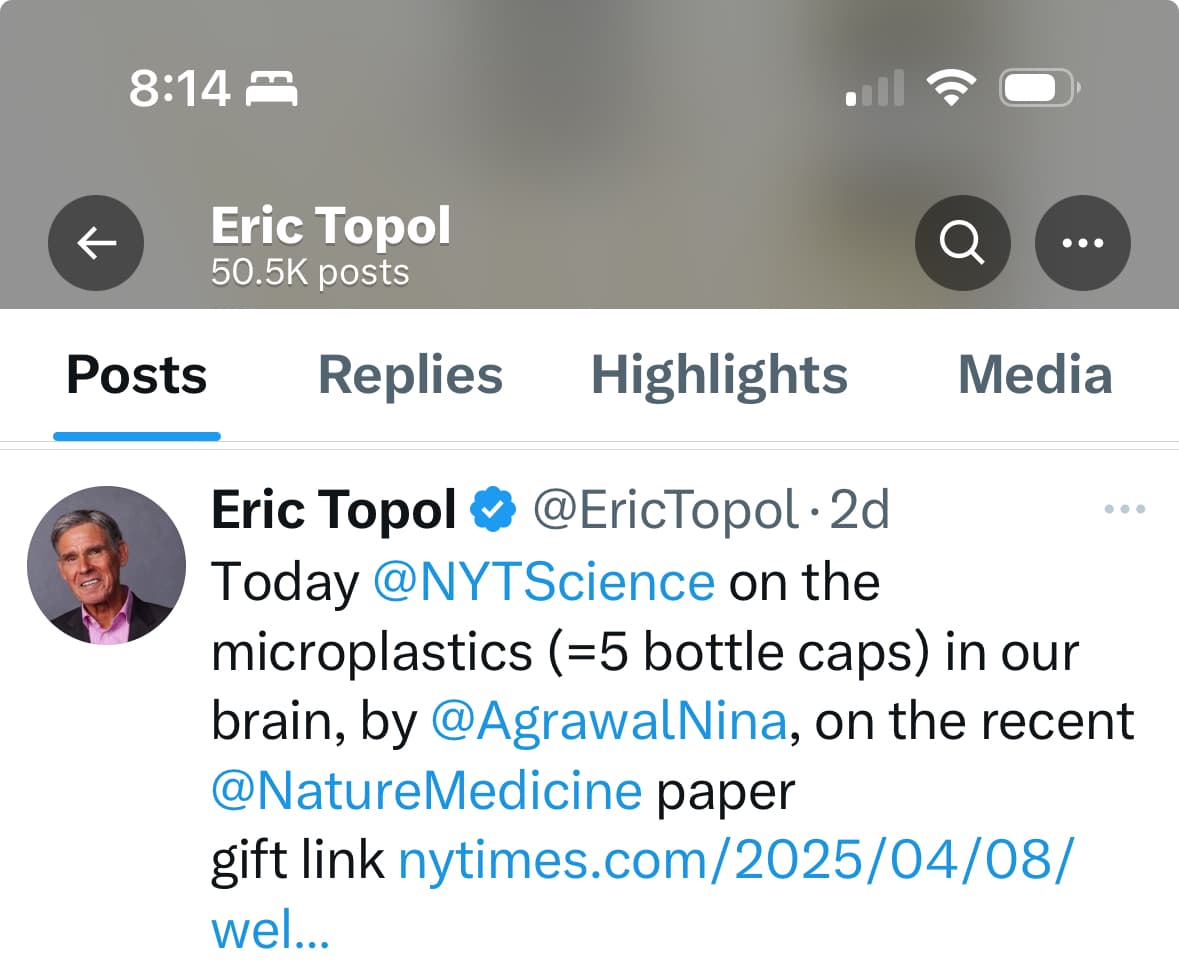https://www.nytimes.com/2025/04/08/well/microplastics-health.html
Signal boosted in the first uploaded youtube video

(https://www.youtube.com/watch?v=0PT5c1z3LL8 and https://www.youtube.com/watch?v=RRBN_4L09Mg)
I’ve stopped putting the plastic lids of foods/spice containers back on, given that MPs are released during friction of putting the lid on/off. I know people who visit can find it… strange…
I need to find some washable drawer/cabinet organizers. Clear plastic containers are the best solution I can find, but I’ve hesitated adding more plastic to the house.
Aside from being bad for the planet, if the plastic does not come in contact with our food, is there any harm you know of? I assume not, but I thought I’d ask.
There are probably 6 g of plastics in your brain.
Tea bags are the worst:
So I took my wife out last night for Mothers Day, Red Lobster. On the table was a grinder of sea salt (which has a large number of microplastics already) and the grinder was made of plastic. It seems like salt would be harder than plastic so I don’t even see how it works over time. My AI friend says " polyoxymethylene (POM), a type of plastic, release thousands of microplastic particles per 100 milligrams of ground salt" That’s what they’re made of.
So… no salt on my food, which some of you think is a longevity thing anyway.
While research into their long-term health effects is ongoing, and there are no targets for “safe” amounts of microplastics in our bodies, a 2024 study in the New England Journal of Medicine (NEJM) linked the presence of microplastics in arterial plaque to a significantly higher risk of cardiovascular events. Researchers have also connected micro- and nanoplastic exposure to inflammation, immune dysregulation, and metabolic disruptions.
Still, we’re early in understanding what these exposures mean for human health. There are no established safety thresholds for microplastics in the body. But the absence of a limit doesn’t mean the absence of risk.
To help readers understand where exposure might be coming from, we’ve ranked common foods and beverages from the lowest to highest measured microplastic load per serving. But particle count isn’t the whole story. Researchers are measuring how much plastic is in our food—not yet how much harm it might cause.
7 Foods and Beverages That Have the Most Microplastics
1. Sea Salt
Plastic Load: ~0.4–5.8 particles per teaspoon (5g)
2. Beer
Plastic Load: ~2–79 particles per liter
3. Bottled Water
Plastic Load: ~325–10,000 particles per liter
4. Shellfish
Plastic Load: ~7.6–10.7 particles per gram (shrimp); ~1.4/g (oysters)
5. Rice
Plastic Load: ~13 mg plastic per 100g of Instant Rice; ~3–4 mg plastic per 100g washed rice
6. Apples and Carrots
Plastic Load: ~44.6 million particles per apple; ~14.7 million particles per carrot (150g)
7. Tea
Plastic Load: ~11.6 billion From 1 plastic tea bag.
Just imagine thinking you are eating a healthy carrot. What can we still eat without polluting our tissues and organs, including our brains, with micro- and nanoplastics. ![]()
It is bad news after bad news. Indeed it appears that likely the impact of all this plastic accumulation on our health, contributing to (systemic and local) inflammation has been hugely underestimated.
And it seems hardly possible to avoid this - besides trying to move to a pristine, remote area, only eating local produce and praying for the best.
Are others not stressed out? Alex just posted how an injection with a syringe introduces tens of thousands of microplastics past the skin barrier and also silicone oil, and in another thread people are discussing injecting peptides every day, without appearing concerned about it. (That’s besides the fact coring will also introduce polymers of the silicone rubber/PP stopper into the compound in the vial).
I put salt in my metal pepper grinder and it corroded the metal ![]()
I haven’t looked into alternatives
On the medical front…
Two of my cats need sub q fluids and the vets are happy to buy the cheaper bags that contain DEHP. The bags get heated which even makes the issue worse.
(I personally buy DEHP free)
In Sept, Newsom signed a bill to ban DEPH bag and tubes, but not surprisingly, it doesn’t take effect until 2030 for bags and 2035 for tubes. The majority of what is used out there do contain DEHP. The long deadlines that are ALWAYS given are a pet peeve of mine.
This is really concerning, Beth. I’m not sure what even to say at this point. ![]()
Volatile organic compound (VOC) release - not sure I’d recommend jumping into that rabbit hole. But I also use quite a lot plastic cabinet organisers - transparant storage boxes work so well. Softer plastics such as PVCs that contain higher levels of plasticizers, generally release higher amounts of VOCs compared to harder plastics though.
Your post also reminded me of articles I read about the supposedly very high level of PFAS in pet food packaging, and tick/flee products.
Sigh….
Thanks for those links. And yeah, lucite organizers are the best… I’m still searching for an alternative
Fortunately I had the good sense not to use pesticides in the house, but that was only because I worried about the cats stepping in it and then licking their paws… it turns out my love for them has helped me!
Speaking of VOCs (good point you made!)
How bad is silicone? I invested in the Dosey silicone bags to organize all my supplements and now wondering…
And…our old glass food containers with plastic lids will soon be replaced (lasted over 15 years!). Most of the good glass containers I ca find, even if they have glass lids, have silicone gaskets to help them seal. What are the thoughts about those seals, and can they go in the dw? Life is too short to hand wash anything but knives ![]()
This is concerning, for sure. One practice that can help to minimize MNPs is to use a 0.22u syringe filter when transferring newly-reconstituted peptides into a sterile GLASS cartridge which is then used in a pen syringe. The only MNPs that could be introduced after that would be from any coring of the tiny rubber stopper whenever a new needle is placed on the pen for each new injection, but at least this needle is very tiny (typically 31g or 32g).
Edit: after reading some of @AlexKChen posts in the other thread, the rubber/plastic plunger in the glass vials could be another source of MNPs. Hopefully the glass cartridges aren’t also lubricated with silicone oil.
What Experts Want You to Know About Microplastics
How can you minimize your exposure? How worried should you be about the health effects? And other questions, answered.
Recent headlines (including in this publication) have raised concerns about microplastics in our bodies and the harm they may be doing.
Scientists say it could be years before we have a full understanding of how these tiny plastic particles are affecting human health. But we do know they have been found from the depths of the Mariana Trench to the heights of Mount Everest. And we know that plastic is accumulating in our bodies, too.
“The air we breathe, the water we drink, the food we eat — it’s in it,” said Richard Thompson, a marine biologist at the University of Plymouth who coined the term “microplastics” in a 2004 paper. “We’re exposed.”
Read the full story: https://www.nytimes.com/2025/05/20/well/microplastics-health-risks.html?unlocked_article_code=1.Ik8.hsdK.vMMklIWKum18&smid=url-share
I am happy to share our new study looking at a surprising and overlooked source of hashtag#microplastic and hashtag#nanoplastic pollution - hashtag#household hashtag#dishwashers. For the first time, we measured hashtag#nanoplastic release (10 nm to 1 µm) from hashtag#dishwashers, using analytical methods I developed to study nanoplastics in hashtag#Australian hashtag#drinking hashtag#water. We found that washing hashtag#plastic hashtag#containers and hashtag#utensils in a dishwasher can release up to 920,000 plastic particles in a single cycle, adding up to an estimated 33 million particles per household per year globally. While the total plastic mass is relatively small (around 6 mg per person annually), the number of particles, and their potential environmental and health impacts, are significant.
During dishwashing, plastic items are exposed to high heat, detergents, and mechanical abrasion, conditions that accelerate the release of both hashtag#micro- and hashtag#nanoplastics into hashtag#wastewater.
This study is a reminder that even routine, everyday actions can contribute to plastic pollution in our environment.
Forward looking solutions such as built-in filters in dishwashers or plastics designed to better resist degradation can help reduce this pollution at the source.
Small changes, when multiplied across millions of hashtag#households, can help address the growing global challenge of plastic pollution.
Grateful to the team and collaborators involved in this important work. Kevin Thomas Ben Tscharke
What’s up with all the “hashtags”?
https://www.eurekalert.org/news-releases/1084276
is apharesis https://genomicpress.kglmeridian.com/view/journals/brainmed/aop/article-10.61373-bm025l.0056/article-10.61373-bm025l.0056.xml ever done without plastic tubing

